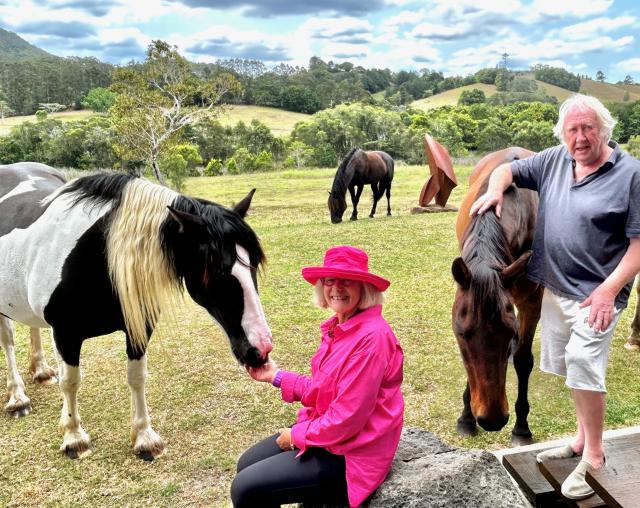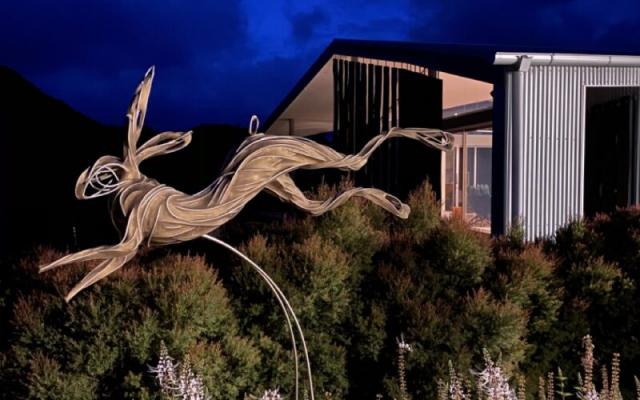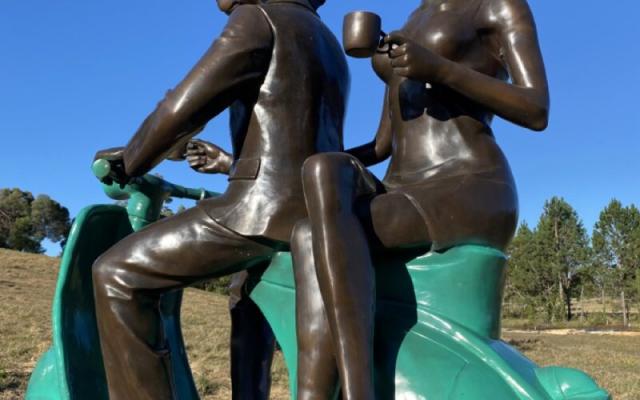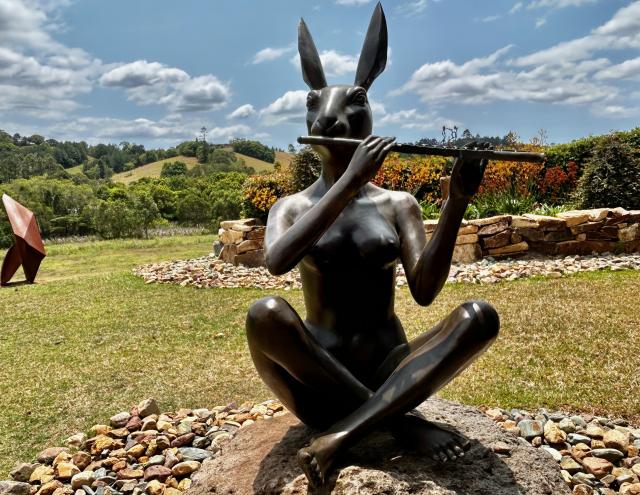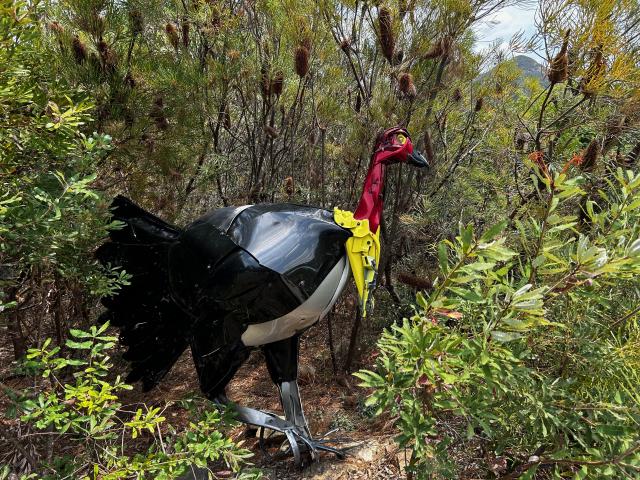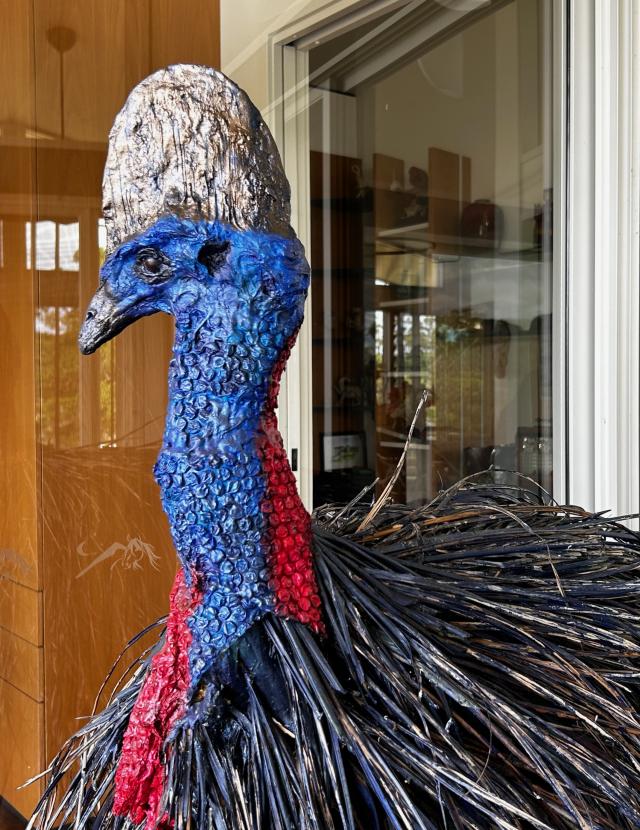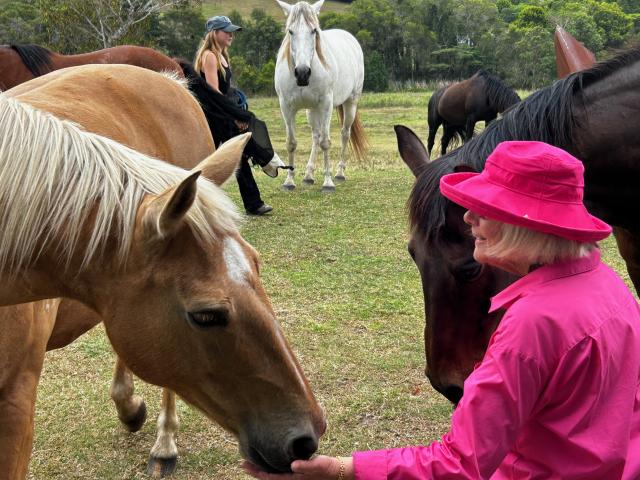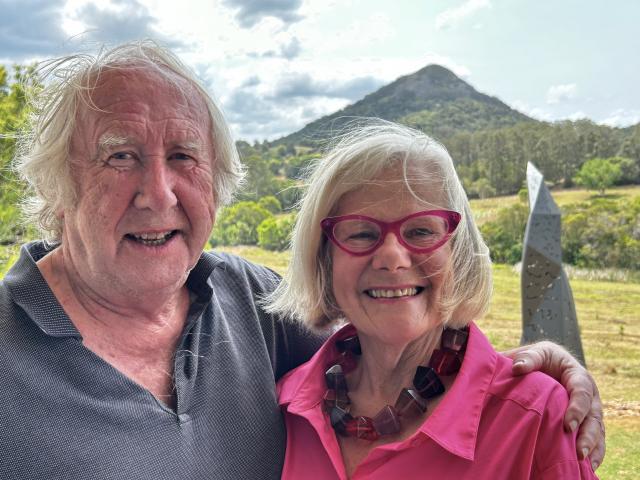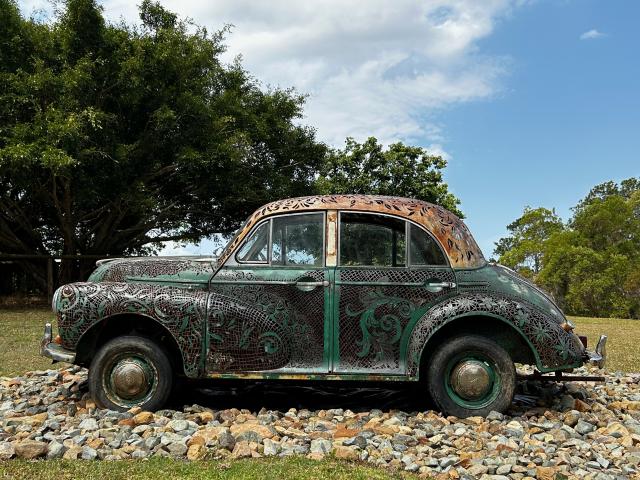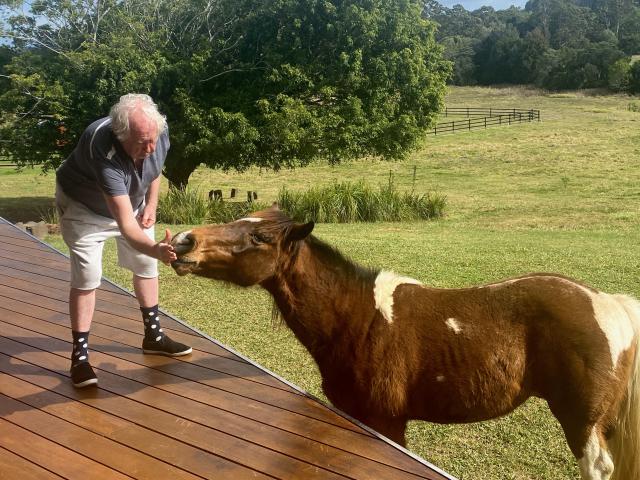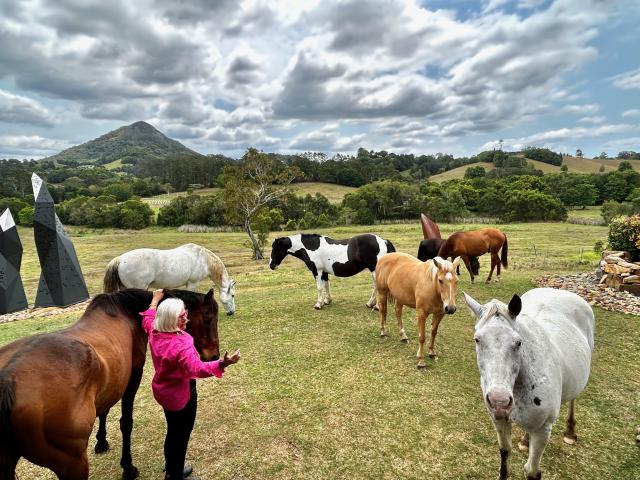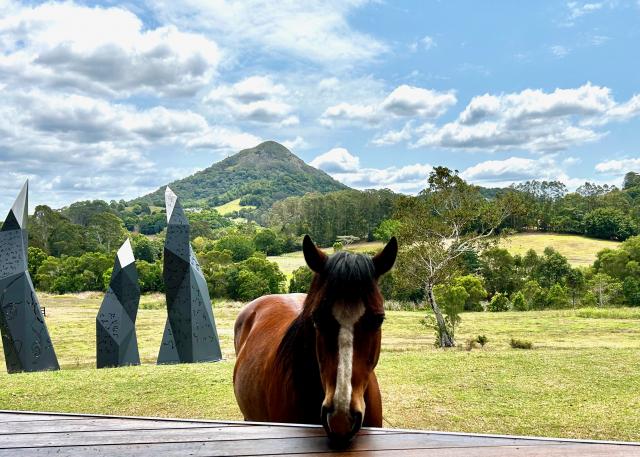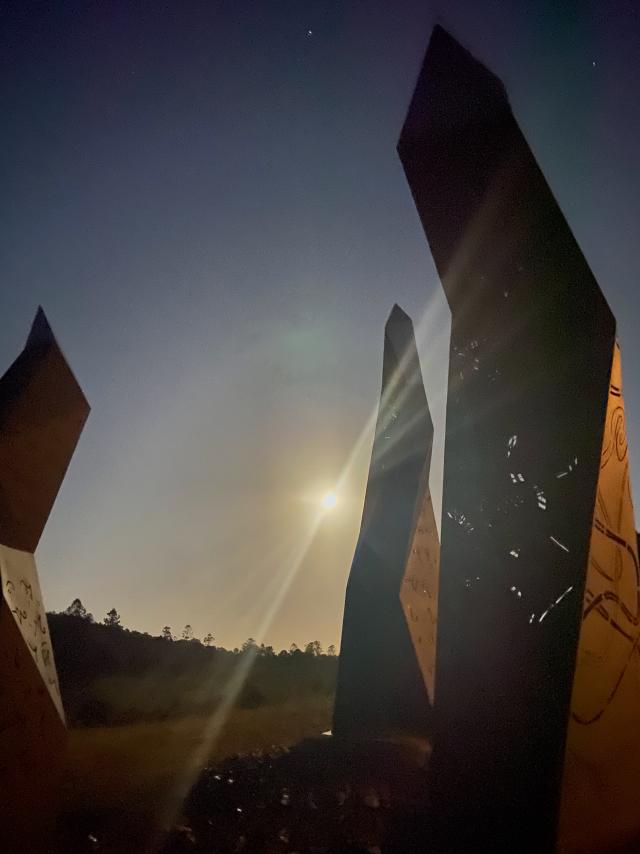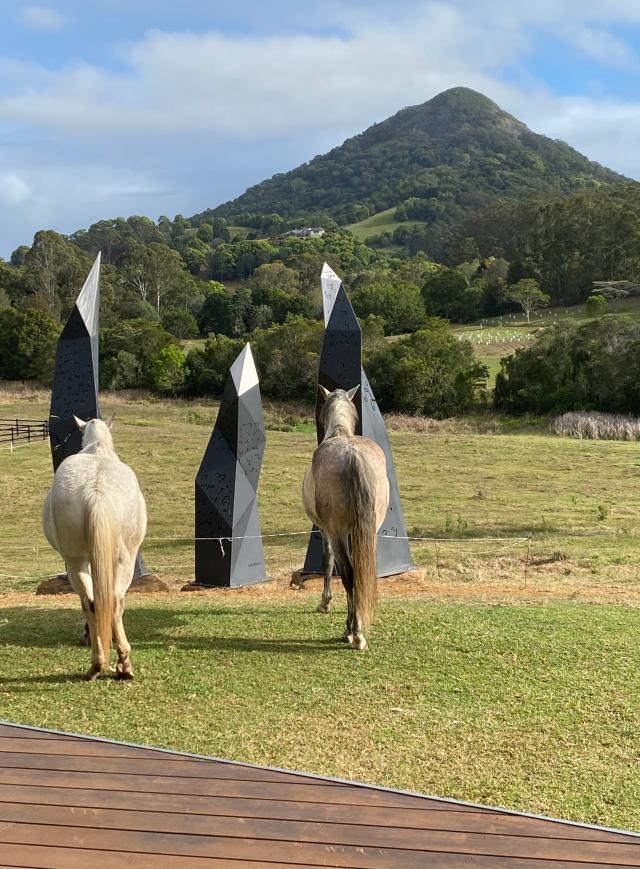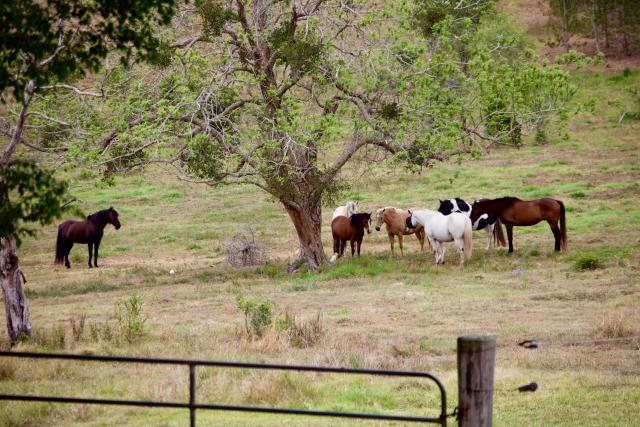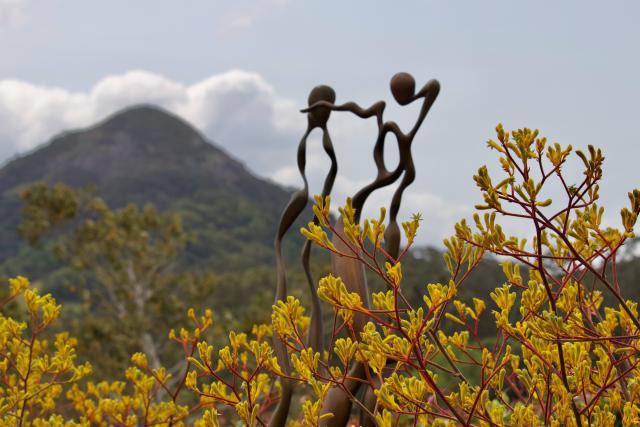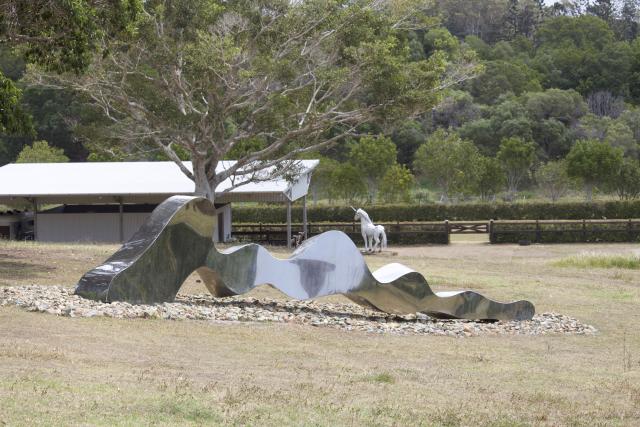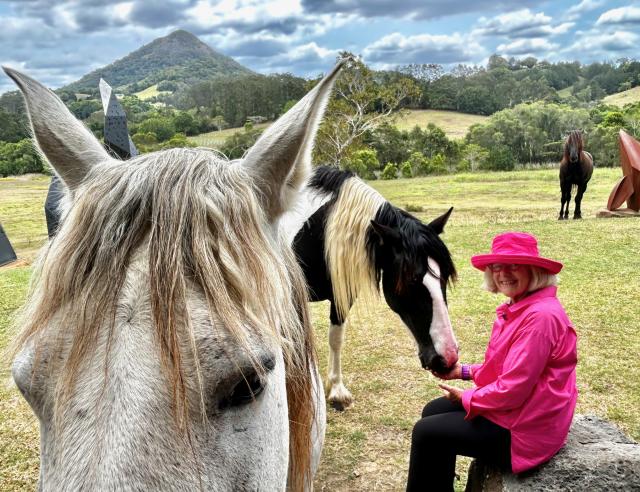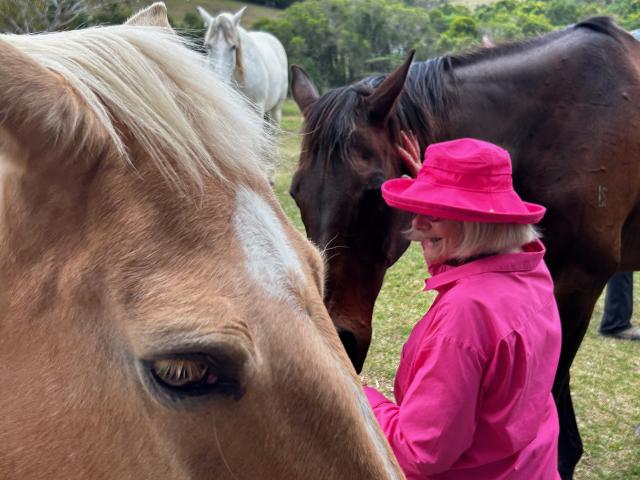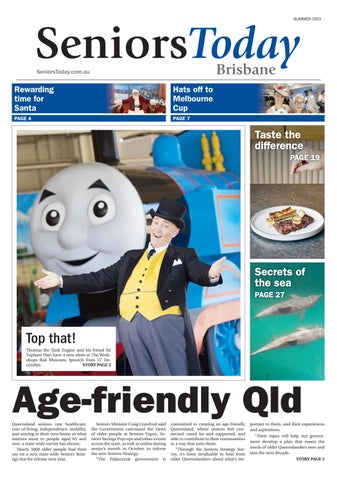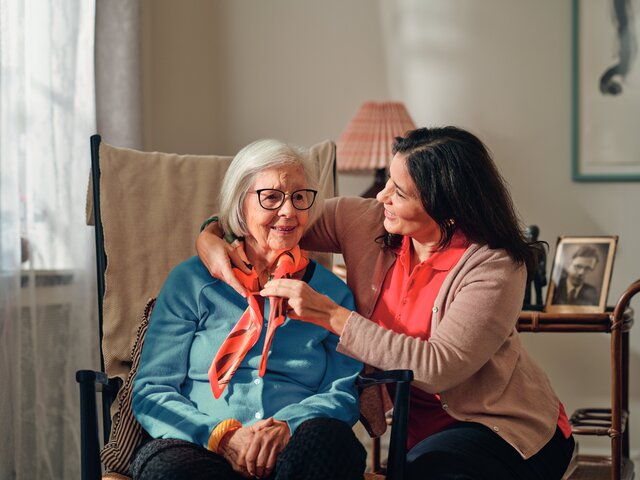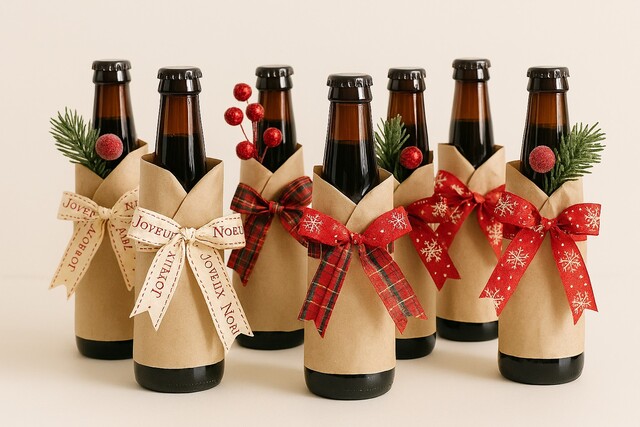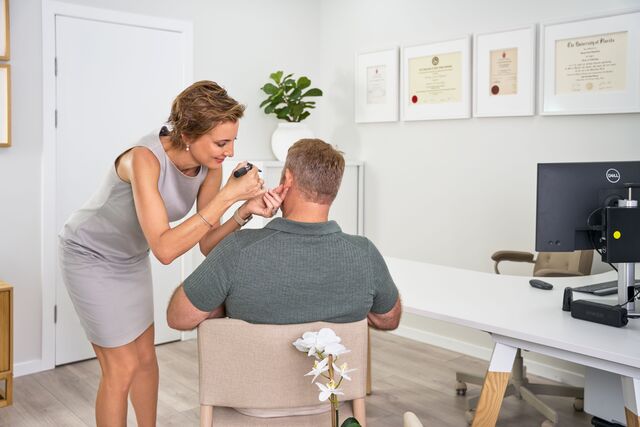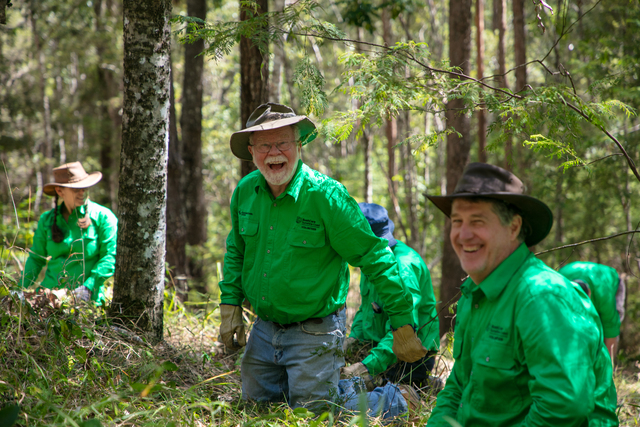PRECEDE
Moon Mountain Sanctuary is filled with beauty, wildness, freedom, inspiration, challenges and creativity. ERLE LEVEY finds a place where art is at home in a landscape filled with wildlife and horses.
BREAKOUT QUOTE
“As a child my Dad gave me books about the Spanish horses. Suddenly I’m living the dream.“
To see the full moon rise over the rolling hills to the east gives a sense of wonder. Especially with the blend of man-made sculptures and the beauty of Cooroy Mountain silhouetted against it.
Moon Mountain Sanctuary is like no other.
Lynn and Ron Scott are not just advocates for good design and architecture, they are patrons of the arts, lovers of locally sourced and produced food, passionate about the environment, and about touching the land lightly, so they leave it in a better condition than when they arrived.
They love animals – horses in particular.
But they don’t just care for their herd – the horses are part of the family.
The deck at the front of their home has been purposely designed at perfect head height for their horses to come to the deck in the mornings or afternoons to say hello, be given a scratch and fed some carrot.
That’s where we are – on the deck, enjoying a fresh coffee while discussing architecture, food, music, art and travel.
The herd of horses roam freely in front of us on the 35-acre property. The land slopes down to a spring-fed creek and beyond that the magnificence of Cooroy Mountain.
Around the property are stunning pieces of sculpture ranging from flute-playing or Vespa-riding figures by Gillian Mark to a dragon fly the size of an ultra-light plane. From works created from recycled car parts by Nick Warfield to a river of steel flowing down the hill. From a life-size cassowary to a Bob Hawke look-alike cockatoo. Towers of stone or a stylised Morris car to depict the ravages of time and family.
Then there’s the a hare by Colleen Lavender mounted so that it perpetually seems to be running or hopping in the garden.
Pinnacles reach skyward to reflect the light of the full moon.
Moon Mountain Sanctuary is the result of Ron and Lynn understanding that lives and loves can evolve and become intertwined.
In doing so something truly special can be created.
As well as a sanctuary for animals and wildlife, it is a design hub – to encourage emerging artists as well as provide an exceptional setting to display the works.
One of the aims of Ron and Lynn is to encourage local sculptors, artists and restauranteurs – helping those passionate about their craft to reach others – with design, art and architecture events.
There are also workshops on the care of horses.
Born in Melbourne, Ron went to Albury High School on the Victoria-New South Wales border as, he said, “my Dad shifted around a bit.’’
“I moved to Sydney for uni and never went back. Attained my Bachelor of Commerce and stayed 40 years.
“First up we lived at Balmain. That was for about 30 years … before it became gentrified.
“It was a beautiful town, the last to get traffic lights. There were some gracious old terraced homes.
“They used to play real music in the pubs. Those who moved into the area later stopped the music.
“There is not the same charm now.
“The power house was still generating when we were there.’’
It was in this setting that Ron founded Creative By Design which went on to become a national franchise for quality furniture and cabinetry.
Lynn grew up on a farm at North Richmond, in Sydney’s north west, and that is where she started to ride horses.
Her father was in the Navy so she helped her mother run the cattle property.
“I went to uni in the city and studied art but wanted to study vet science.
“In those days it was a huge no-no for women.
“I was awarded a scholarship but my parents were encouraged not to follow it up as it ’wasn’t a career for a woman.’
“Now it is, and most are women.
“It would have crushed me though as you are dealing with some very sick animals.
“So I studied geography and was a teacher for a while, attaining a Master of Education.’’
Ron’s love of music at a young age would see him hitchhike from Albury to Sydney for concerts.
“That’s when music was music. I would go to Sydney of a weekend to see Billy Thorpe. And Glenn Shorrock in Melbourne.’’
These weekends away were just a taste of things to come, with Ron travelling extensively – particularly through North America.
Lynn is highly educated in environmental management and has authored many books and won awards on the topic.
She is an avid supporter of rewilding, which is a progressive approach to land conservation.
Both are avid bird watchers and their photos bear testament to many adventures, particularly to the rainforests of Far North Queensland.
They support letting nature take care of itself, enabling natural processes to repair and restore damaged ecosystems and degraded landscapes.
Through rewilding they are creating more biodiverse habitats and Lynn has had the energy lines mapped on their property to maximise where trees and planting should go to ensure success.
“It’s a dual thing,’’ she said, explaining her interest in the natural environment.
“Ron has a love of interior design and beauty created by people but my interest was in beauty created by nature initially.
“Eventually you evolve and intertwine.’’
Part of life is that you see other things your partner is interested in. This includes the art galleries and history in Europe to the understanding of the Australian landscape and the aboriginal art.
“It’s just amazing,’’ Lynn said. “I remember as a kid picking up stone axe heads while Dad would plough the field.
“That gave me an early interest. What we have done is combine our interests.’’
The house, designed by Peter Ireland of Allen Jack+Cottier, is a work of art in itself. Built by Noosa’s Ron Scholes, it captures the intent of Lynn and Ron perfectly.
It is overlooking the property yet sheltered from the westerly winds by a ridgeline and elevated to have minimum impact on the land.
There are massive areas of glass to bring in natural light and make the most of the outlook, large overhang over the north-facing deck to bring shade in summer and warmth in winter.
Above all, it opens up the view of Cooroy Mountain directly in front, and provides a constantly-changing work of art as the herd of horses move about the property.
Winner of an architectural Good Design Award in 2020, it had a most unusual proposition at the heart of the project.
“I love good design,’’ Ron said. “Put creative people together and it’s the biggest joy.’’
The key, Lynn said, was that with a really creative architect – one that you’ve worked with on a number of projects – you learn to trust them.
“We’ve never double-guessed Peter on his design.
“This home can be confronting. It’s a farm shed. A facade.
“That said, this is a shed that was built on a farm, but once through the front door it virtually explodes with the height of the raised ceilings and you get the whole of the mountain in front of you.
“That was the hard part.
“We left the design to Peter rather than get a second voice … we left the design to him but got involved in the internal fit-out.’’
That’s where patience was needed, Ron said.
“Every single thing you see here is individually chosen. The lights, the door fittings … the whole process needs patience if you want the best outcome.’’
Lynn added: “You cannot hurry the creative process. It’s evolutionary.’’
It’s then you realise how our lives can be dictated by early experiences yet we evolve as we grow.
Lynn noted how wonderful it was that in our youth we could spend so much time dreaming about things.
“I read National Geographic as a child – that played such a big part. Dad would bring the magazines home.
“I realised there was a big world out there, outside of the North Richmond School. And I wouldn’t have had that exposure otherwise.’’
When Lynn and Ron moved to Eumundi, there was the original house that had been built in 1918, and a tractor shed.
“I wanted a horse arena in a better site, one with better energy,’’ Lynn said.
“So we decided to separate the home and horse shed.
“The shed has been designed so there is little chance of the horses injuring themselves. There are no stables.
“I’ve had horses since I was young but when you marry and have a career, horses go out of your life for a while.
“On my 50th birthday Ron gave me a horse. We bought a farm in Sydney to retire that horse, then we got another one.
“Then brumbies, which are rescue horses obviously. Once you get brumbies, if you truly watch them and don’t want to dominate them or ride them, then a different way of handling horses turns up.
“And that’s what happened. We are here.’’
It must be like having dogs as pets. They become part of the family.
“When a horse comes here, they don’t leave,’’ Lynn said.
“We have imported some.
“I’m living my dream. As a child my Dad gave me books about the Spanish horses.
“Suddenly I’m living the dream. The ones we have are from Europe with the true attributes of the breed.’’
Their Eumundi house is designed for its setting and the environment, Ron said.
“We’d been looking for eight to nine years before we bought it. Murray Brown and David Lafferty were very helpful.
“I have the greatest admiration for Murray.’’
For Lynn, it was imperative to retain and re-establish the significant riparian corridors for wildlife.
“Having been a dairy farm, we needed to regenerate the land – get rid of the cattle and introduce horses.
“We understand horses are grazing animals that can move 20km in a day. There are no internal fences other than the mare and stallion yards, so the horses can run.
“They move over the whole property.
“There is no overgrazing. There are areas that they graze and others they leave until the grasses seed and grow back.
“As horse managers, we have to consider that introduced grasses can be too high in sugars, and there was the issue of needing to decalcify the land due to setaria grasses.
“That is a risk for horses.
“It’s about control of grasses.’’
On coming to Eumundi, Lynn said they sat for two years to understand the land.
“All the seven horses by that stage came with me.
“The architect watched the horses. The original fig trees are where they gather.
“We needed a horse shelter. Not a traditional shed.
“Peter came up with a concept of having the tack room and feed room at the middle of the trunk of the “tree’’ and then cantilevered the roof so there are no struts for horses to run into.
“At the same time it was cantilevered enough for the whole herd to shelter out of the sun, the wind and the rain.’’
During their time at Eumundi, no one horse has taken over the territory. There are no bullies in the herd.
“Things are together yet separate,’’ Lynn said, “… retreats have been created.
“The horses are part of the landscape, the house, the family.
“I come from a slightly different position in having wild brumbies. I took those that no-one else could handle. Totally wild.
“It took six months for one to freely come to me.
“It’s a very long journey and you learn to let the horse make the decision. You don’t.’’
When building the house, it was Lynn’s dream to live with the horses, to give them access.
The design is a matter of safety too. They cannot come into the house.
“Peter cleverly designed the verandah. Where most would put a fence around the house, the only fence is to keep them out of the garden.’’
The garden gives continuity to the old cottage. Birds are attracted. Tortoises come up to it to lay their eggs.
“So many accidents can happen when a horse runs into a fence during a huge electrical storm,’’ Lynn said.
Which is why Lynn and Ron have removed many fences and are working towards a more natural terrain.
“As humans, if we empower the animals we have in our life, to make their own decisions, we empower a relationship on a completely different level.
“The horses choose to come up here of a morning.
“One of the hardest things is brumbies know wild horse behaviour yet domestic horses don’t. We have removed everything a horse depends on. We’ve changed and removed socialisation away from them, that their domestic life had depended on.
“The psychological damage caused to humans in jail can be the same with horses.
“Wild horses are based on harmony and cohesion, not aggression.
“Life’s a lot better with a harmonious inter-relationship.’’
Respecting the wishes of each other is important with horses as well as with humans.
“If you want long relationships you both have to build interests of each other and respect those,’’ Lynn said.
“Ron’s interest is in design, art. He has created this sculpture park.
“He has gone out and sourced them, commissioned them. He is the person who has built the dream here. That’s very important in harmonious relationships.’’
For Ron, there is not one simple answer for this love and support of art.
He used to travel widely in the US, attend music festivals and visit galleries as well as museums.
“Those days of travel have probably gone.
“Here, I sometimes commission a sculpture to be done of an animal on the farm.
“They’ve all got their own charm … but the scale is getting bigger.’’
As Ron and Lynn say, their goals are not the ordinary, not the safe, not the normal.
“We seek out differences, inspiration, challenges.
“Our goals are not about safe, they are about finding new and different ways to approach art forms, farming, horse husbandry and indeed life.
“Our choices of art forms need to challenge. We seek out whimsical, the joy, the juxtaposition of the unexpected.
“This also translates to the same search for differences in the life with a wild horse herd.
“Different views on how to live – with our horses allowed the herd to be art in movement.
“The herd freely moves over the farm. Restrictive barriers such as fences are dispensed with and the free movement determines the rhythm of the day, including the human rhythm.
“That vision extends to the trees, shrubs, sedges and grasses.’’
Lynn and Ron wanted to help forge a close relationship with their herd of horses.
In doing so, they have created an artistic environmental wildlife and horse property that demonstrates that it is possible to integrate a working farm with the protection and re-establishment of ecosystems.
Leaving their property, I could not help but be reminded that as you travel through life, it’s quite incredible the way the world opens up to you – if you have the time to stop, to look and to listen.
The people you meet, the stories they tell, the landscapes that you see, the art, the beauty of nature. It helps gain an understanding of the land, the history of the world and the cultures of the people who have trod the Earth.

